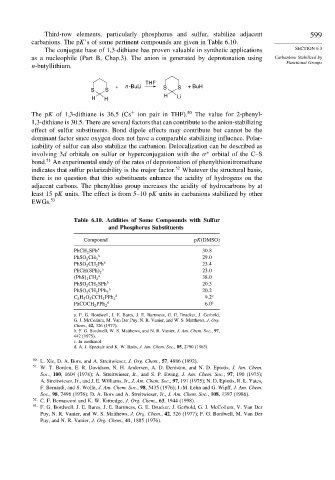Page 617 - Advanced Organic Chemistry Part A - Structure and Mechanisms, 5th ed (2007) - Carey _ Sundberg
P. 617
Third-row elements, particularly phosphorus and sulfur, stabilize adjacent 599
carbanions. The pK’s of some pertinent compounds are given in Table 6.10.
The conjugate base of 1,3-dithiane has proven valuable in synthetic applications SECTION 6.3
as a nucleophile (Part B, Chap.3). The anion is generated by deprotonation using Carbanions Stabilized by
Functional Groups
n-butyllithium.
THF
+ n -BuLi S S + BuH
S S
H
H H Li
The pK of 1,3-dithiane is 36.5 (Cs + ion pair in THF). 50 The value for 2-phenyl-
1,3-dithiane is 30.5. There are several factors that can contribute to the anion-stabilizing
effect of sulfur substituents. Bond dipole effects may contribute but cannot be the
dominant factor since oxygen does not have a comparable stabilizing influence. Polar-
izability of sulfur can also stabilize the carbanion. Delocalization can be described as
involving 3d orbitals on sulfur or hyperconjugation with the
orbital of the C–S
∗
51
bond. An experimental study of the rates of deprotonation of phenylthionitromethane
indicates that sulfur polarizability is the major factor. 52 Whatever the structural basis,
there is no question that thio substituents enhance the acidity of hydrogens on the
adjacent carbons. The phenylthio group increases the acidity of hydrocarbons by at
least 15 pK units. The effect is from 5–10 pK units in carbanions stabilized by other
EWGs. 53
Table 6.10. Acidities of Some Compounds with Sulfur
and Phosphorus Substituents
Compound pK(DMSO)
PhCH 2 SPh a 30 8
b 29 0
PhSO 2 CH 3
PhSO 2 CH 2 Ph b 23 4
a 23 0
PhCH SPh 2
a 38 0
PhS 2 CH 2
PhSO 2 CH 2 SPh b 20 3
b 20 2
PhSO 2 CH 2 PPh 2
d 9 2 c
C 2 H 5 O 2 CCH 2 PPh 2
d 6 0 c
PhCOCH 2 PPh 2
a. F. G. Bordwell, J. E. Bares, J. E. Bartmess, G. E. Drucker, J. Gerhold,
G. J. McCollum, M. Van Der Puy, N. R. Vanier, and W. S. Matthews, J. Org.
Chem., 42, 326 (1977).
b. F. G. Bordwell, W. S. Matthews, and N. R. Vanier, J. Am. Chem. Soc., 97,
442 (1975).
c. In methanol.
d. A. J. Speziale and K. W. Ratts, J. Am. Chem. Soc., 85, 2790 (1963).
50
L. Xie, D. A. Bors, and A. Streitwieser, J. Org. Chem., 57, 4986 (1992).
51
W. T. Borden, E. R. Davidson, N. H. Andersen, A. D. Deniston, and N. D. Epiotis, J. Am. Chem.
Soc., 100, 1604 (1978); A. Streitwieser, Jr., and S. P. Ewing, J. Am. Chem. Soc., 97, 190 (1975);
A. Streitwieser, Jr., and J. E. Williams, Jr., J. Am. Chem. Soc., 97, 191 (1975); N. D. Epiotis, R. L. Yates,
F. Bernardi, and S. Wolfe, J. Am. Chem. Soc., 98, 5435 (1976); J.-M. Lehn and G. Wipff, J. Am. Chem.
Soc., 98, 7498 (1976); D. A. Bors and A. Streitwieser, Jr., J. Am. Chem. Soc., 108, 1397 (1986).
52 C. F. Bernasconi and K. W. Kittredge, J. Org. Chem., 63, 1944 (1998).
53
F. G. Bordwell, J. E. Bares, J. E. Bartmess, G. E. Drucker, J. Gerhold, G. J. McCollum, V. Van Der
Puy, N. R. Vanier, and W. S. Matthews, J. Org. Chem., 42, 326 (1977); F. G. Bordwell, M. Van Der
Puy, and N. R. Vanier, J. Org. Chem., 41, 1885 (1976).

